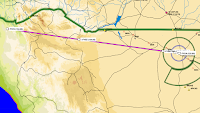When I searched the web for flying over Golden Gate Bridge, I found several links for the "Bay Tour." This turned out to be a moderately difficult technical flight, VFR through class B airspace 1 mile west of SFO.
On 12/26/16, we rented a C172 for the day from Aerodynamic Aviation, N62244, and few from KMRY to KPAO which was the starting point for our flight. When ready to go, we contacted ground 125.00 with our request:
 |
| Flight route from ForeFlight on Google Maps |
N62244: Palo Alto ground, Cessna 62244 with information kilo, request straight out for transition through San Carlos for Bay Tour.
KPAO-G: 62244, squawk 0344
This was followed by taxi instructions to run up spaces just short of runway 31. Then onto the tower, 118.6:
N62244: Palo Alto tower, Cessna 62244 ready to go for Bay Tour, altitude 1500
KPAO-T: 62244, winds calm, clear for take off, straight out departure approved
A couple of miles north of Palo Alto:
KPAO-T: 62244, contact San Carlos tower 119.0
N62244: 244, contact San Carols tower.
N62244: San Carols tower, Cessna 62244 with you, 1500 for Bay Tour
KSQL-T: 62244, remain east of 101, landing traffic, I'll fly you over the airport.
San Carlos tower cleared another airplane to land runway 30, then got back to me.
KSQL-T: Skyhawk 62244, cross over mid field, then remain west of 101
N62244: 244, cross mid field, then west of 101
As we flew away from San Carlos airport, we were prepared to circle the Bay Meadows racetrack area, but this did not turn out to be necessary.

KSQL-T: 62244, contact San Francisco tower 120.5
N62244: 244, contact San Francisco tower
N62244: San Francisco tower, Cessna 62244 with you at 1500
KSFO-T: 62244, altimeter 3022, you are cleared into class bravo, remain south and west of 101, maintain below 1500 and above 1200.
N62244: 244, south and west of 101, below 1500 and above 1200

We were the only traffic in the SFO transition, so keeping west of route 101 and east of the Santa Cruz mountains while maintaining altitude between 1200 and 1500. Staying east of interstate 280 was important, because just west of the interstate is Sweeney Ridge, about 1200 elevation with peaks above 1400. We were only 1 mile from the SFO terminal, and it was easy to see the landings on 28L and 28R. Several times, the tower pointed out departures from SFO and warned about wake turbulence. The were departing to the northeast on 01L and 01R, so wake turbulence was never a factor. About 3 miles north, tower released us to Norcal approach.
KSO-T: 62244, you're 2 miles from the class bravo boundary, contact Norcal approach 136.1
N62244: 244, contact Norcal 136.1, thank you for your help
N62244: Norcal approach, Cessna 62244 with you at 1400.
NCal-A: 62244, Bay Tour approved. Remain north of the Bay Bridge.
We flew over Daly City, west of the San Bruno Mountain (elevation 1300) at 1500. This is also called Sign Hill, because of the, "SOUTH SAN FRANCISCO, THE INDUSTRIAL CITY" sign on the south side. Then, we started a gradual climb to 2000 as flew west of Twin Peaks and the Sutro television tower (elevation 1814) .

Norcal approach notified us of traffic circling near the Golden Gate bridge, but otherwise, we had the bay to ourselves. We flew to the east side, then turned back west along the bay bridge. After the photographing the Golden Gate bridge, we headed south to the Half Moon Bay Airport.
At the KHAF, we found we were late for lunch at the 3-zero restaurant, but we were told about the parking area past the end of runway 30. There we found a security gate, then a bridge to a street in El Granada where there were some restaurants. We finished our Bay Tour with lunch. Hobbs time for the flight was 0.9 hours.















































